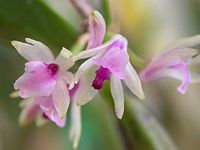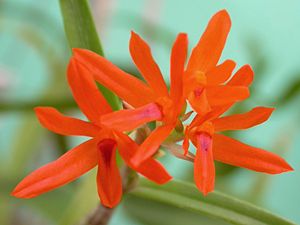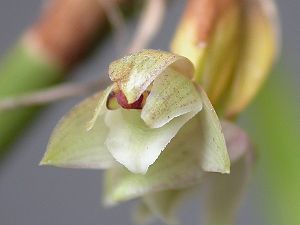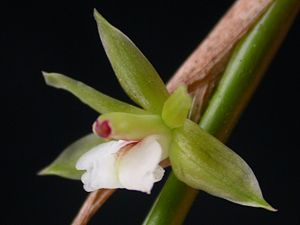Scaphyglottis
| Scaphyglottis | ||||||||||||||||||||
|---|---|---|---|---|---|---|---|---|---|---|---|---|---|---|---|---|---|---|---|---|
 Scaphyglottis stellata
| ||||||||||||||||||||
| Scientific classification | ||||||||||||||||||||
| ||||||||||||||||||||
| Type species | ||||||||||||||||||||
| Fernandezia graminifolia Ruiz & Pavón 1798 | ||||||||||||||||||||
| Species | ||||||||||||||||||||
| ||||||||||||||||||||
| Synonyms | ||||||||||||||||||||
|
Scaphyglottis is an orchid genus formed by almost seventy species characterized by the habit of shooting new pseudobulbs both from the apex and from the base of older ones. A great variety of different plant and flower morphologies which have been described as distinct genera through the years are today considered synonyms of Scaphyglottis. Many species are similar and hard to distinguish, while a few are easy to recognize. Scaphyglottis is a genus widespread throughout the tropical New World. Their flowers are usually small and pale dull colored, however, some species have bright red, purple or green flowers. As they usually bloom again, during several years, on the same pseudobulbs they become interesting plants to the orchid enthusiasts and are occasionally found in orchid collections. Further than the hobbyist interest, Scaphyglottis species were used by popular medicine as pain relievers and, in 2007, it was reported that extracts of S. livida, had antinociceptive and anti-inflammatory properties in mice.[1]
Distribution
The sixty nine currently accepted Schaphyglottis species[2] are spread throughout wide area from South of Mexico to South of Bolivia an all Brazil except south region, from sea level to high altitudes on the Andes. They exist in several Caribbean islands, where, usually, are endemic species. The South of Central America, where most of the species occur, can be considered their center of distribution.[3]
Schaphyglottis are epiphytes, occasionally rupicolous, which often form large desorganized colonies, sometimes ascending or pending from the tree branches. They habit both warm and humid forests of low altitudes from the coastal areas and Amazon as, less frequently, dry jungles on the plateaus. Few species are occasionally found in cloud montane forests in the Andes and Costa Rica, then ordinarily in open sunny areas or on the top of the trees.[4]
Description
The size of Schaphyglottis plants is highly variable. There are delicate tiny species that barely surpass a few centimeters to large and robust ones also reaching one meter heigh. All species show elongated narrow pseudobulbs, on the base protected by several ephemeral sheaths which remain for long time after dried. The pseudobulbs grow both superposed from the apexes and occasionally from the bases of older pseudobulbs forming a long chain; they bear up to three apical leaves.[4] The leaves generally are thin and flat, narrow and elongated although some species have almost terete fleshy leaves.
The inflorescence shoots from the extremity of the pseudobulbs and, different from most orchids, which just bloom once each pseudobulb, Scaphyglottis blooms during several years from older ones. As the pseudobulbs are superposed giving the impression of a long stem, and the older ones bloom again the flowers appear to be along this stem and not on the apexes of each pseudobulb as they really are. The inflorescences may be panicles or racemes, bearing one, few or many, clustered or spaced flowers, which open simultaneously or in succession.
Their flowers are small, generally pale white, cream, green, pinkish, but pale, the exception are the flowers of species that belonged to the genus Hexisea, mostly red;[4] the petals and sepals present similar lengths however the petals usually are wider and the labellum the largest floral structure, frequently with its apex reflected, the base attached to the salient column foot forming a chin, often articulated but sometimes fused to it. The anther is terminal and may contain four or six pollinias.
Scaphyglottis can be separated from its closest genera, among which Jacquiniella is the most noted, because the other genera present cauline pseudobulbs covered by alternating leaves and flowers of columns without a foot.[4]
Most of Scaphyglottis species are pollinated by short tongue insects because almost all produce nectar that accumulates in the mentioned chin. The species of red flowers possibly are also pollinated by hummingbirds, birds which have a preference for red flowers.[3]
Taxonomic notes
The genus Scaphyglottis was proposed by Eduard Friedrich Poeppig and Stephan Ladislaus Endlicher,[5] in 1835. In 1960 Robert Louis Dressler designated Fernandezia graminifolia as its type species, which became Scaphyglottis graminifolia.[6] Scaphyglottis comes from the Greek skaphe, hollow, and glotta, tongue, a reference to the shape of the labellum of its flowers.[5]
Before the current definition of Scaphyglottis, the genus was uncertain for a long time.[7] There is a large group of species clearly belonging to this genus, besides others that where occasionally classified under the genera Tetragamestus, Leaoa and Hexadesmia which were subordinated to Scaphyglottis decades ago, however, many species still were classified under the genera Hexisea and Platyglottys until recently. Every group of species of each one of these genera show some morphological particularities and not always are easily identified as Scaphyglottis species. In 1993, a revision of Scaphyglottis was published and, although the genera submitted to it after this date were not treated on this paper, it is very useful to elucidate the majority of the similar species that form this genus.[7] However, as this paper is not readily available and no comprehensive book has ever been published, the majority of the core species of Scaphyglottis remains not easy to identify to the lay person. This happens both because there is no bibliography and because there are many similar species some spread by wide areas and highly variable with many intermediate morphologies and also endemic variations that have been described as distinct species.
In 2004, other genera were subordinated to Scaphyglottis to fulfill the current phylogenetic concepts.[8] The differences which motivated the description of these genera, today its synonyms, are the following:
Hexadesmia: Is a genus that subordinated twenty seven names, among them fifteen good species. It was described by Adolphe Théodore de Brongniart,[9] in 1842. It was formed by species different from Scaphyglottis because its flowers have six pollinia instead of four. As all these species show in a basal placement on Scaphyglottis clade, it is supposed that this is the ancestral condition of this genus.[3]. Several taxonomists subordinated species to Hexadesmia, among them Schlechter and Reichenbach.
Leaoa: in 1922 Rudolf Schlechter and Paulo de Campos Porto [10] described this small genus for one species that so far was called Hexadesmia monophylla, which presents a very long solitary inflorescence, again with six pollinia, instead of short multi fascicles with several flowers. More species were added to this genus by Leslie Andrew Garay, in 1955,[11] and by Brieger,, in 1976,[12] raising to three the number of species classified under this genus.
Tetragamestus: was described in 1854, by Heinrich Gustav Reichenbach,[13] to Tetragamestus modestus. Four were the species attributed to this genus, the last by Schlechter em 1818.[14] The plants of this group have flowers with a labellum that has a chin les salient than the ones submitted to the other genera. The most noted species was the type species, Tetragamestus modestus, a name that causes confusion with Reichenbachanthus modestus, as both had the same name and are both Scaphyglottis now. The first retained the name as Scaphyglottis modesta, the later is now called Scaphyglottis brasiliensis. Tetragamestus still is widely used by enthusiasts who ignore the unification of this genus with Scaphyglottis.[15]
Reichenbachanthus: was proposed by João Barbosa Rodrigues,[13] in 1882 when he described Reichenbachanthus modestus, now Scaphyglottis brasiliensis. Six pendent epiphyte species that exist from Central America to Southeast Brazil, in humid and shady forests were once subordinated to this genus. The last was in 1997 by Dressler.[16] They can be identified by their similar terete leaves and pseudobulbs, instead of clearly distinct pseudobulbs and thin leaves of the other Scaphyglottis. Their flowers, however, are not much different from the ones of Scaphyglottis.
Reichenbachanthus have branched pseudobulbs, with thickened internodes, and acute arching leaves. their inflorescences are short, solitary or fasciculate, with small pale green or cream flowers. The petals are lanceolate, slightly smaller and highly narrower than the sepals. The labellum is entire or slightly trilobed, flat but with acute or bilobed apex, ocasionally reflected, completely folded, united to the column foot forming the mentioned chin. The column is thick and elongated with apical anther and four pollinia. There are homonyns with other Scaphyglottis species: a species from Serra do Mar, Reichenbachanthus modestus, originally classified as Fractilinguis brasiliensis and nor Scaphyglottis brasiliensis; Other confusion was with Fractiunguis reflexus, that is the same Reichenbachanthus emarginatus now called Scaphyglottis emarginata, and another from north of Amazon, Reichenbachanthus reflexus today Scaphyglottis reflexa.[2]
Fractiunguis: was created by Schlechter, in 1922,[17] and was soon considered a synonym of Reichenbachanthus. It was formed by the same three species of the later.
Hexisea: was proposed by John Lindley in 1834, to Hexisea bidentata.[18] The name of this genus is a reference to the six petals and sepals of its flowers that have similar shapes and sizes. Thirteen names were submitted to this genus, five of them accepted until it was merged with Scaphyglottis. The last Hexisea species to be described was Hexisea arctata, in 1979, by Dressler. They are medium sized plants, epiphyte or rupicolous, of caespitific growth forming large colonies, in humid tropical and equatorial forests of low altitude from South of Mexico to North and Northeast of South America.
Hexisea species distinguish from the other Scaphyglottis by their almost entirely red flowers, which have a immobile labellum, partially fused by their base edges to the base of the column forming a shallow nectary, instead of having a free labellum as most Scaphyglottis. It is the only group pollinated by hummingbirds.[3] Their vegetative morphology is very similar to the other Scaphyglottis species although they tent to be more reddish. Their leaves are thin and are present for a couple of years on the articulations between the pseudobulbs. The inflorescences are racemes with few simultaneous flowers, generally two or three. The flowers have lanceolate sepals, the lateral slightly wider than the dorsal, the petals are similar to the sepals. The labellum is simple, folded down, or the same color of the rest of the flower, in some species with a pair of yellow tooth like calli close to its base, on other absent or less visible. The lateral sepals are slightly fused on their bases. They have four pollinia.[7]
According to the rules of the International Code of Botanical Nomenclature, Hexisea is the name that should be used to all Scaphyglottis species as it is previous to the later, however, an exception was opened and the second names was conserved over the first to avoid the too many name changes of noted species.[6]
Euothonaea: was proposed in 1852 by Reichenbach when considering that the description of Hexisea of Lindleys was invalid as it did not fulfilled technical requirements.[19] This genus was always considered a synonym of Hexisea.
Costaricaea is a genus proposed by Schlechter in 1923[20] for Costaricea amparoana but, as the last genus, was almost immediately placed under synonymy of Hexisea.
Platyglottis: was proposed in 1942 by Louis Otto Williams.[21] It was formed by one species only, Platyglottis coriacea from Panama, which shows superposed pseudobulbs, but that are similar to the ones of Epidendrum, with several alternate wide flat and leathery leaves; and apical raceme inflorescence bearing up to four pale flowers that do not open well and are spaced bu an thickened elongated ovary with large inflated bracts at the base of the peduncle. Both vegetative and floral morphology make easy to differentiate this species from other Scaphyglottis.
According to the phylogeny of Laeliinae published in 2000 by Cássio van den Berg,[22] Scaphyglottis, belongs to a clade with Jacquiniella and Acrorchis, inserted between the clades of Epidendrum and of Encyclia.
In 2004, Dressler, William Mark Whitten and Norris H. Williams,[8] published an article on the phylogeny of Scaphyglottis, where the showed that Reichenbachanthus, Platyglottis, and Hexisea species where mixed to Scaphyglottis ones inside the clades, therefore, to keep Scaphyglottis monophyletic, several nomenclature changes would be necessary, with the creation of more similar genera. Too avoid this chances they suggested the unification of all mentioned genera into Scaphyglottis. As the limits between many of these genera have been always confusing, the suggestion was soon a consensus among the taxonomists.
References
- ↑ Déciga-Campos, M. et al. (2007) Antinociceptive and anti-inflammatory effects of compounds isolated from Scaphyglottis livida and Maxillaria densa in J. Ethnopharmacol 114:161-8.
- ↑ Jump up to: 2.0 2.1 R. Govaerts, M.A. Campacci (Brazil, 2005), D. Holland Baptista (Brazil, 2005), P.Cribb (K, 2003), Alex George (K, 2003), K.Kreuz (2004, Europe), J.Wood (K, 2003, Europe) (accessed March 2009). World Checklist of Orchidaceae. The Board of Trustees of the Royal Botanic Gardens, Kew. Published on the Internet.
- ↑ Jump up to: 3.0 3.1 3.2 3.3 Robert Dressler (2001). Scaphyglottis in A. M. Pridgeon, P. J. Cribb, M. W. Chase, and F. N. Rasmussen eds., Genera Orchidacearum vol. 4: 310-3. Oxford University Press, Oxford, UK ISBN 0198507127.
- ↑ Jump up to: 4.0 4.1 4.2 4.3 Hoehne, Frederico Carlos (1940). Orchidaceae - introduction in Flora Brasílica vol. 12-1. São Paulo.
- ↑ Jump up to: 5.0 5.1 Poeppig, Eduardus and Endlich, Stephano (1835). Scaphyglottis in Nova genera ac species plantarum, quas in regno Chilensi Peruviano et in terra Amazonica, (Leipzig) F. Hofmeister (Editor), 1835-45. 1: 58.
- ↑ Jump up to: 6.0 6.1 Robert Louis Dressler (1994). Proposal to conserve Scaphyglottis against Hexisea (Orchidaceae) in Taxon 43: 665-6.
- ↑ Jump up to: 7.0 7.1 7.2 Adams, Bryan Roger (1993). A taxonomic revision of the genus Scaphyglottis (Orchidaceae - Epidendroideae). Southern University at Carbondale, IL.
- ↑ Jump up to: 8.0 8.1 Dressler, Robert Louis, Whitten and N.H. Williams (2004). Phylogenetic relationships of Scaphyglottis and related genera (Laeliinae: Orchidaceae) based on nrDNA ITS sequence data in Brittonia 56: 58–66.
- ↑ Brongniart, Adolphe Théodore de (1842). Hexadesmia in Annales des Sciences Naturelles; Botanique, sér. 2, 17: 45.
- ↑ Schlechter, Rudolf and Porto, Paulo de Campos (1922). Leaoa in Archivos do Jardim Botânico do Rio de Janeiro 3: 292.
- ↑ Garay, Leslie Andrew (1955). Leaoa reedii in Archivos do Jardim Botânico do Rio de Janeiro 13: 45.
- ↑ Brieger, Friedrich Gustav (1976). Leaoa hondurensis in Orchideen 8(29-32): 488
- ↑ Jump up to: 13.0 13.1 Reichenbach, Heinrich Gustav (1854). Tetragamestus in Bonplandia (Hanover) 2: 21. Cite error: Invalid
<ref>tag; name "RCHB" defined multiple times with different content - ↑ Schlechter, Rudolf (1818). Tetragamestus antillanus in Beihefte zum Botanischen Centralblatt 36(2): 400.
- ↑ Archives of Coordenadoria das Associações de Orquidófilos do Brasil (2008). Orchid shows reports of 2008.
- ↑ Robert Louis Dressler (1997). Reichenbachanthus subulatus in Novon 7(2): 124.
- ↑ Schlechter, Rudolf (1922).Fractiunguis in Anexos das Memórias do Instituto de Butantan: Secção de Botânica 1(4): 55. São Paulo.
- ↑ Lindley, John (1834). Hexisea bidentata in Journal of Botany, being a second series of the Botanical Miscellany 1: 7.
- ↑ Reichenbach, Heinrich Gustav (1852). Euothonaea in Botanische Zeitung. (Berlin} 10: 772.
- ↑ Schlechter, Rudolf (1823). Costaricaea in Repertorium Specierum Novarum Regni Vegetabilis, Beihefte 19: 30.
- ↑ Williams, Louis Otto (1942). Platyglottis in Annals of the Missouri Botanical Garden 29(4): 345.
- ↑ van den Berg, C. and M.W. Chase. (2000). Nomenclatural notes on Laeliinae - I in Lindleyana 15(2): 115-119.


